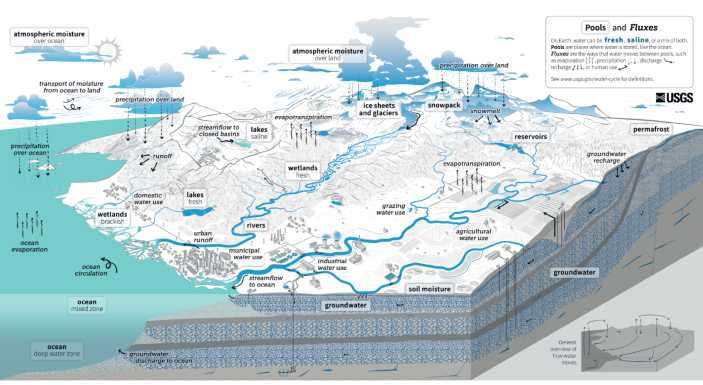Climate change is not just about getting drier or getting wetter when it comes to water availability. We should work towards a more comprehensive process understanding of the water cycle that accounts for human actions.
We cannot emphasize enough the importance of the water cycle. Explaining and predicting the changes in water availability is no easy task, as water is stored and moves naturally across its pools, namely the atmosphere, Earth’s surface and underground (The Water Cycle; USGS, 2022).

In the past two decades, climate science researchers have debated over two hypothesized frameworks for trends in water availability under climate change: that wet will get wetter and dry will become drier (WWDD) or that global aridification (GA) will happen. There exist extensive and sometimes contentious studies to evidence each hypothesis, leaving us wondering which one is correct.
There might be no definite right or wrong in this case. In their Review in this issue, Benjamin Zaitchik and colleagues examine the physical bases and limitations basis of WWDD and GA based on the water-cycle budgets, including precipitation, evapotranspiration, the sum of runoff and the change in water storage.
The validity and predictive capacity of each framework depend on the specific context. WWDD may hold if the change in atmospheric moisture flux divergence is equal to the change in precipitation minus evaporation. Zaitchik et al. reviewed the successes and failures of the WWDD and concluded that WWDD applies best if the so-called wet and dry areas are defined based on seasonality rather than long-term average conditions. It would fail for applications in predicting water availability over a specific land location.
The limitations of GA were discussed by firstly distinguishing meteorological, hydrological and agroecological aridity. The trends in each form of aridity are sensitive to the associated processes. GA may be valid for meteorological aridification considering only atmospheric supply (precipitation) and demand (for example, potential evapotranspiration, relative humidity or vapour pressure deficit), and for hydrological aridification when defined in terms of soil moisture, but seems not to hold for runoff (hydrological aridification) or for agroecological aridification that considers ecological change. Like the WWDD, GA should also not be mistaken for water availability predictions at precise locations.
Despite the limitations and complications of both frameworks, they can be useful for developing and testing hypotheses through careful considerations of appropriated contexts in both atmospheric and water perspectives, particularly the temporal and spatial scales. However, the widely used phrases WWDD and GA may have led to misapplication of the frameworks and misunderstanding of the responses of the water cycle to the changing climate. The phrases may be easy to remember and attract attention, but they do not refer to any specific process or variable that underlies the frameworks.
We might all hope for a definitive answer to the question of whether there will be more or less water for us in the future, but the reality is too complicated to be explained by a simple answer. The Review tells the story of us learning about the water cycle and seeking answers: from observations to hypotheses, then to applications and theories. As emphasized by Zaitchik et al., we would be better off using simplified frameworks as an entry point for studying processes, focusing on detangling processes in the water cycle rather than assuming generalized outcomes, and on a careful assessment of regional- and seasonal-scale changes. And, of course, we should also account for the interference of human actions on the water cycle.
Rights and permissions
About this article
Cite this article
How climate change alters the water cycle. Nat Water 1, 485 (2023). https://doi.org/10.1038/s44221-023-00104-6
Published:
Issue Date:
DOI: https://doi.org/10.1038/s44221-023-00104-6
